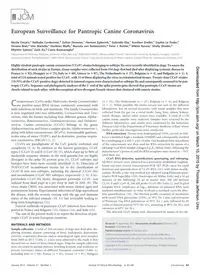
2013 European Surveillance for Pantropic Canine Coronavirus PDF
Preview 2013 European Surveillance for Pantropic Canine Coronavirus
European Surveillance for Pantropic Canine Coronavirus Nicola Decaro,a Nathalie Cordonnier,b Zoltan Demeter,c Herman Egberink,d Gabriella Elia,a Aurélien Grellet,e Sophie Le Poder,e Viviana Mari,a Vito Martella,a Vasileios Ntafis,f Marcela von Reitzenstein,g Peter J. Rottier,d Miklos Rusvai,c Shelly Shields,g Eftychia Xylouri,f Zach Xu,g Canio Buonavogliaa Department of Veterinary Medicine, University of Bari, Bari, Italya; INRA-ENVA-ANSES, Maisons-Alfort, Franceb; Szent István University, Budapest, Hungaryc; Utrecht University, Utrecht, The Netherlandsd; UMES, ENVA, Maisons-Alfort, Francee; Agricultural University of Athens, Athens, Greecef; Pfizer Inc., Kalamazoo, Michigan, USAg Highly virulent pantropic canine coronavirus (CCoV) strains belonging to subtype IIa were recently identified in dogs. To assess the distribution of such strains in Europe, tissue samples were collected from 354 dogs that had died after displaying systemic disease in France (n � 92), Hungary (n � 75), Italy (n � 69), Greece (n � 87), The Netherlands (n � 27), Belgium (n � 4), and Bulgaria (n � 1). A total of 124 animals tested positive for CCoV, with 33 of them displaying the virus in extraintestinal tissues. Twenty-four CCoV strains (19.35% of the CCoV-positive dogs) detected in internal organs were characterized as subtype IIa and consequently assumed to be pan- tropic CCoVs. Sequence and phylogenetic analyses of the 5= end of the spike protein gene showed that pantropic CCoV strains are closely related to each other, with the exception of two divergent French viruses that clustered with enteric strains. C oronaviruses (CoVs; order Nidovirales, family Coronaviridae) are positive-sense RNA viruses commonly associated with mild infections in birds and mammals. The family Coronaviridae is now organized into two subfamilies, Coronavirinae and Toro- virinae, with the former including four different genera, Alphac- oronavirus, Betacoronavirus, Gammacoronavirus, and Deltacoro- navirus. Canine coronavirus (CCoV) belongs to the genus Alphacoronavirus and forms a unique species, Alphacoronavirus 1, along with feline coronaviruses (FCoVs), transmissible gastroen- teritis virus of swine (TGEV), and its derivative, porcine respira- tory coronavirus (PRCoV) (1, 2). CCoVs are paradigmatic of the CoV genetic evolution and complexity (3, 4). In addition to the known genotypes, CCoV types I (CCoV-I) and II (CCoV-II) (5), which share up to 96% of nucleotide sequence identity in the viral genome but are highly divergent in the spike (S) protein gene (6), CCoV subtypes and biotypes have been more recently identified (3, 4). Detection of TGEV/CCoV recombinant strains led to the classification of CCoV-II into two subtypes, including the classical (CCoV-IIa) and recombinant (CCoV-IIb) subtypes, respectively (7, 8). A hy- pervirulent CCoV-IIa strain, designated pantropic CCoV, was isolated from dead pups at a pet shop in Italy in 2005 (9). The virus, strain CB/05, was associated with severe clinical signs and postmortem lesions. Experimental infections of dogs reproduced the disease, with the severity varying with the age and immune status of the infected animals (10, 11) but invariably leading to long-term lymphopenia (12). Natural outbreaks of pantropic CCoV infection have been re- ported in France and Belgium (13), Greece (14), and Italy (15). The aim of the present study is to report the detection of pan- tropic CCoV in some European countries. MATERIALS AND METHODS Sample collection. A total of 354 carcasses of dogs that died after dis- playing systemic disease consisting of fever, leukopenia, depression, enteritis, respiratory distress, and/or neurological signs were sampled from 2009 to 2011 (Table 1). Cases were admitted to the study if they showed two or more of these clinical signs. Dogs for sample collection were recruited in animal shelters, breeding kennels, and academic or private veterinary clinics of different European countries (Table 1), including Italy (n � 69), France (n � 92), Greece (n � 87), Hungary (n � 75), The Netherlands (n � 27), Belgium (n � 4), and Bulgaria (n � 1). When possible, the entire carcass was sent to the different laboratories, but on several occasions, only tissue samples that were collected from the gut (or a rectal swab), lung, liver, spleen, kidney, tonsil, thymus, and/or other tissues were available. A total of 2,129 canine tissue samples were analyzed. Samples were screened by the different laboratories, and results were confirmed by the Infectious Diseases Unit of the Department of Veterinary Medicine of Bari, where further molecular investigations were conducted. RNA extraction. Tissues were homogenized (10%, wt/vol) in Dul- becco’s modified Eagle’s medium (DMEM) and subsequently clarified by centrifuging at 2,500 � g for 10 min. One hundred forty microliters of the supernatants was then used for RNA extraction by means of a QIAamp viral RNA minikit (Qiagen S.p.A., Milan, Italy), following the manufacturer’s protocol, and the RNA templates were stored at �70°C until their use. CCoV RNA detection, quantification, genotyping, and subtyping. All RNA extracts were subjected to a previously established TaqMan- based real-time reverse transcription-PCR (RT-PCR) assay for rapid detection and quantification of CCoV RNA (16), with minor modifi- cations. Briefly, a one-step method was adopted using Platinum quan- titative PCR SuperMix-UDG (Invitrogen srl, Milan, Italy) and a 50-�l mixture of the following: 25 �l of master mix, 300 nM primers CCoV-F and CCoV-R, 200 nM probe CCoV-Pb (Table 2), and 10 �l of template RNA. Duplicates of log10 dilutions of standard RNA were analyzed simultaneously in order to obtain a standard curve for abso- lute quantification (16). The thermal profile consisted of incubation with uracil-DNA glycosylase (UDG) at 50°C for 2 min and activation of Platinum Taq DNA polymerase at 95°C for 2 min, followed by 45 cycles of denaturation at 95°C for 15 s, annealing at 48°C for 30 s, and extension at 60°C for 30 s. The detected CCoV strains were characterized by means of two dis- Received 14 September 2012 Returned for modification 8 October 2012 Accepted 12 October 2012 Published ahead of print 24 October 2012 Address correspondence to Nicola Decaro,
